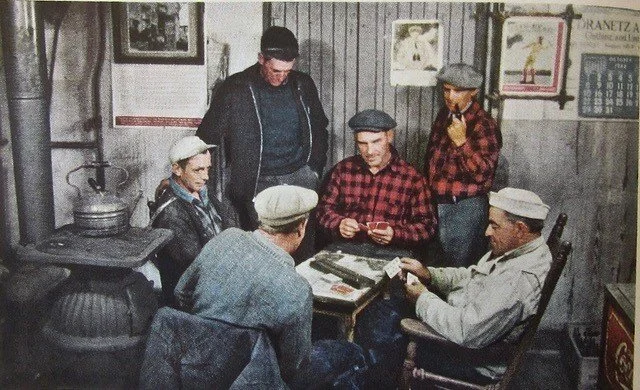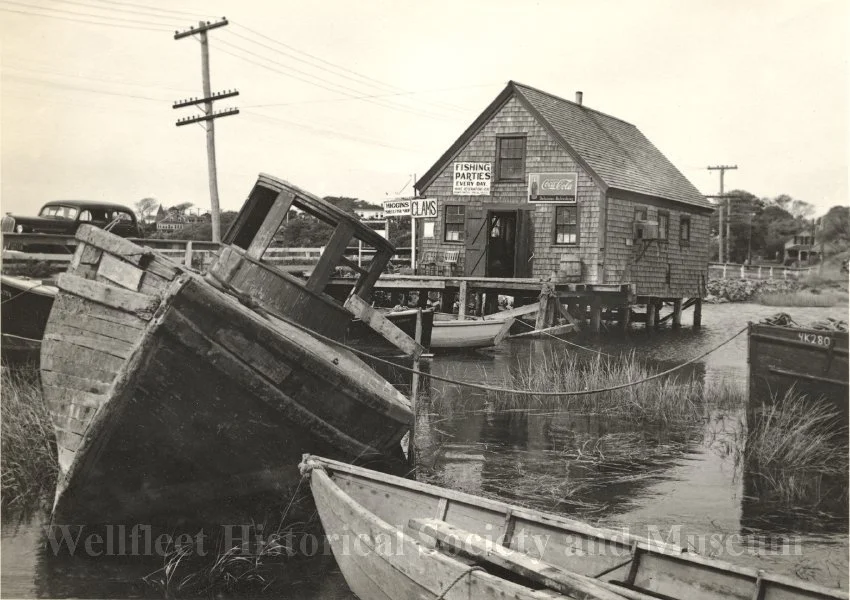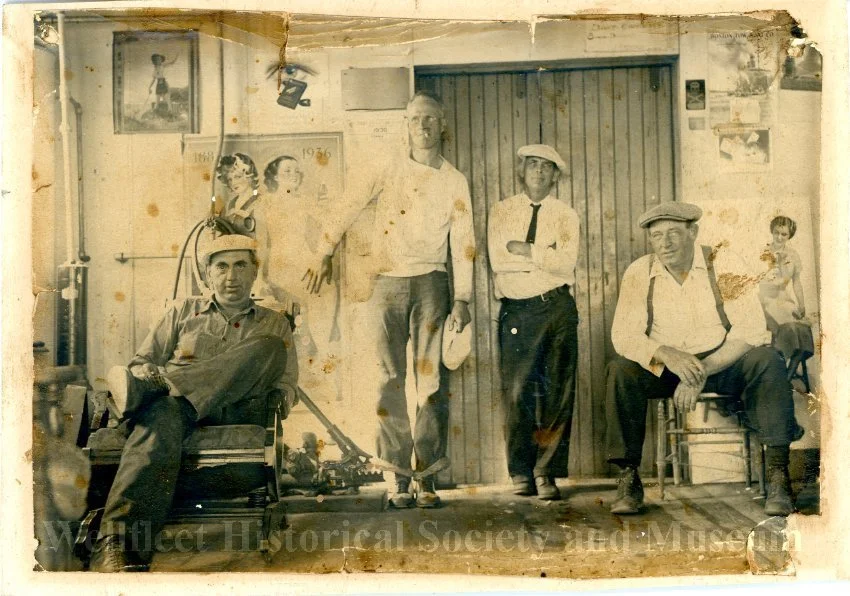The Echo of Voices from Around Wellfleet’s Famous Pot Belly Stove
The Spit ‘n Chatter Club Was Once The Epicenter of Shellfishing Life in Town
Capt. Everett Higgins sold shellfish, “notions,” candy and even the occasional haircut from his former oyster shack, home of the Spit ‘n Chatter Club. (Photo courtesy of the Wellfleet Historical Society Museum)
As Wellfleet oyster shacks go, Capt. Everett Higgins’ was by far the most historic of the many shucking sheds that once ringed the shoreline of Duck Creek.
When he purchased the shed in the mid-1930s, Capt. Higgins’ shack was already famous. While most of town’s shacks over the years were built from discarded lumber or salvaged from derelict fishing boats, The Shellfish Shop, as he named it, had been designed and built in 1898 by an architect for none other than Capt. Lorenzo Dow Baker, Wellfleet’s most important – and wealthiest – resident.
But what made this particular shack famous was not so much its past ownership or even the fact it can still be seen today as part of the main structure of the Pearl Restaurant, just across Commercial Street in front of the Town Pier. It was moved to its present location in the mid-1950s to make room for the big marina then under construction. Its real fame is due to the fact it was also the home of the Spit ‘n Chatter Club, which for nearly two generations was the epicenter of Wellfleet shellfishing life.
Capt. Everett Higgins’ oyster shack was built on the Mayo Beach causeway, a built-up roadway between the Duck Creek and Snow Creek marshes connecting Commercial Street with the town’s harbor and wharves. Behind the shack is Milton Hill, the site of an early Wellfleet cottage colony called the Lemon Pie Cottages. (Photo courtesy of the Wellfleet Historical Society Museum)
Wellfleet’s culture and norms reflect three centuries of hard, dangerous livelihoods from fishing, shellfishing and trading under sail. For much of its history, Wellfleet was an isolated place, an island floating on a long ribbon of shifting sand connected to the mainland. Patterns of communication, social interaction and even entertainment evolved from lives spent living in small, easy-to-heat spaces and working on small sailing ships plying the waters from the Canadian Maritimes to Central America.
It’s easy to imagine how The Shelllfish Shop became a favorite gathering spot for Wellfleet’s leading citizens. The building was sound and, thanks to solid construction and a fine pot belly stove, warm even on the coldest winter evenings. The Shellfish Shop had a public front room where customers could buy fresh shellfish, along with a wide variety of items, including ice, sodas and candy for the town’s children. Haircuts by Capt. Higgins were also available. The private back room, however, was only for socializing. Besides the stove, the room featured an old wooden table. The table, a thick slab of well-worn, plentifully-inscribed wood sat on a wooden barrel with an ancient cribbage board nailed to its center. The table still exists, on view at the Wellfleet Historical Society. Some rickety wooden chairs completed the Spit ‘n Chatter Club’s furnishings. Membership in the club was exclusive: you had to be a resident, you had to be a mariner, and you had to be a shellfisherman. Most importantly, you had to know how to clam up when clients were in the shop. Kids and women were occasionally welcomed, but only to listen in, never to contribute. It was an informal club with irregular gatherings populated by memorable characters. Carved into the tabletop are some of the town’s more illustrious family names, including Rich, Young, Dalby, and Paine. One of the club’s more famous members was Harold Paine, harbormaster and skipper of the Evelyn C, a deep-water scalloper he built with his own hands. Harold never drove a car. He walked everywhere he went. He was a great story teller and, according to Wellfleet historian Edward Lombard, a lyrical wordsmith. “Harold’s profanity was a thing of artistic beauty, even poetical in its delivery,” he wrote in his book, I Heard the Ocean’s Mighty Roar.
Capt. Everett Higgins’ oyster shack featured a davit on its side (shown)where oystering and clamming craft could drop off their catches. In its earlier day, fishing boats past their prime would end their careers slowly succumbing to the mud and the tides. (Photo courtesy of the Wellfleet Historical Society Museum)
The Spit ‘n Chatter Club is still with us. In the mid-1950s the shack was moved off its old locust pilings and transformed into the Capt. Higgins Restaurant, a popular family seafood eatery. Today, as the trendier Pearl Restaurant and bar, it remains an important – and far more inclusive –- gathering spot for a new generation of Wellfleetians.
David Wright, curator of the Wellfleet Historical Society Museum on Main Street, and author of The Famous Beds of Wellfleet, is particularly fond of Capt. Baker’s old oyster shack because of the way it represents the changes in Wellfleet as it transformed from a small isolated Cape Cod oystering village to a thriving vacation community, and yet did so while maintaining so much of its core culture and identity.
The Wellfleet Oyster Alliance agrees, and is proud to name its new newsletter the Spit ‘n Chatter Club. At the height of Wellfleet’s oyster industry in the mid-1850s the great French philosopher Jean-Baptiste Karr penned his most famous words: “The more things change the more they stay the same.” We hope this publication will not only bring the Wellfleet oyster-loving world closer together, but will help our community continue to prosper from the hard work and dedication of our shellfishermen and from the care we all must take to keep our waters healthy and productive.
Spit ‘n Chatter Club members of 1937 standing in front of the Shellfish Shop’s side loading doors. From L to R: Bill Ryder, Ned Sheridan, Capt. Everett Higgins and Capt. Harold Paine. (Photo courtesy of the Wellfleet Historical Society Museum)
With heartfelt thanks to David Wright of the Wellfleet Historical Society and author of The Famous Beds of Wellfleet, an expansive recounting of the town’s rich shellfishing history.
FURTHER READING: Barbara Austin | Herring River Dike | OysterFest’s Homecoming | Upcoming Events




